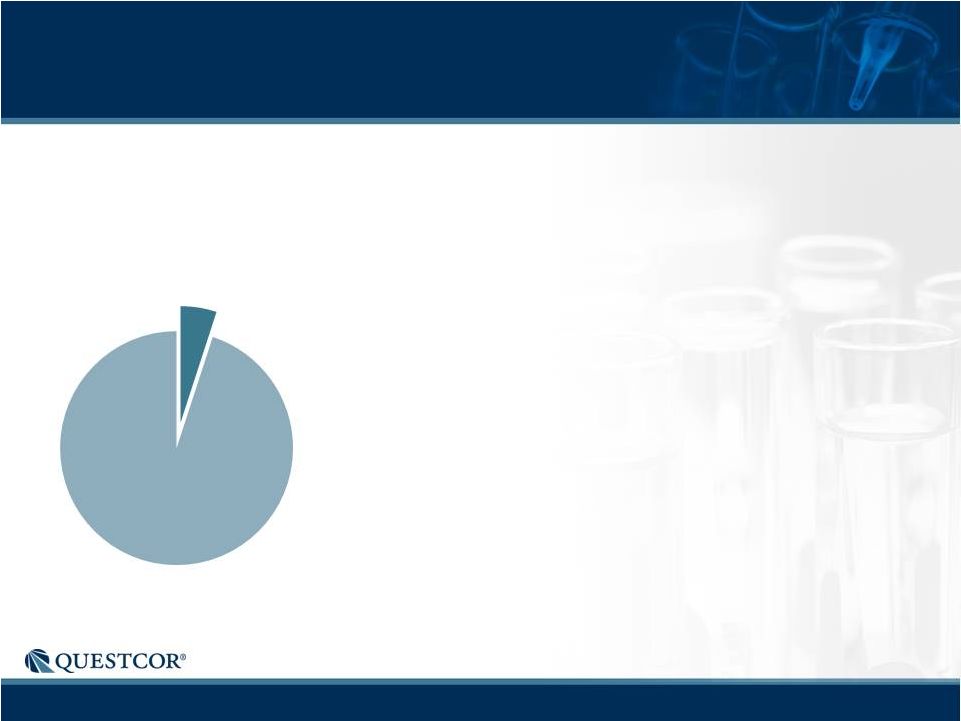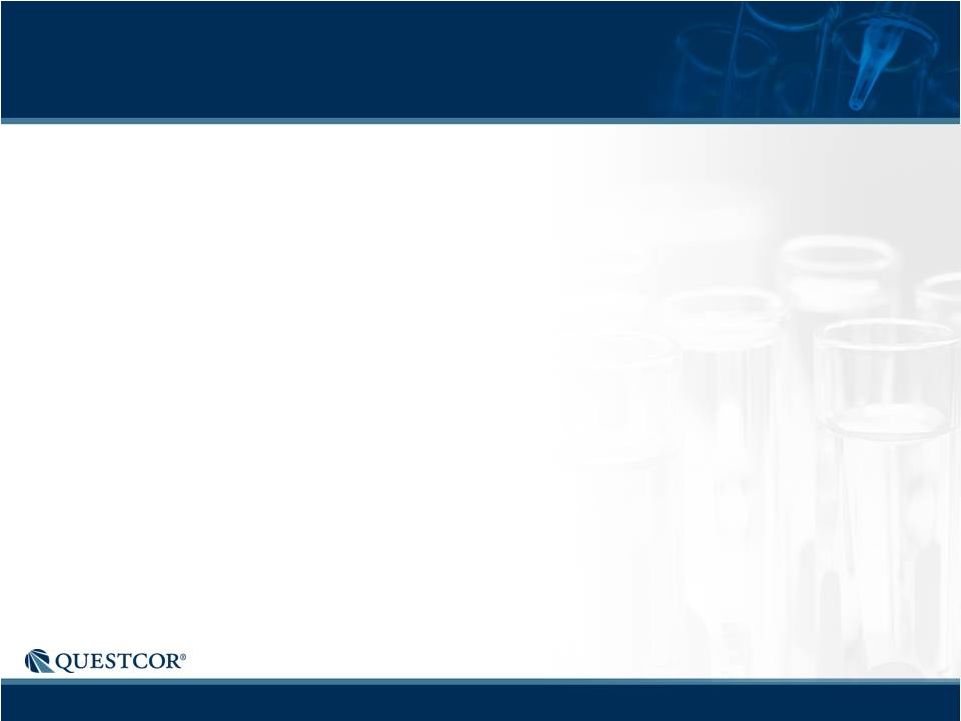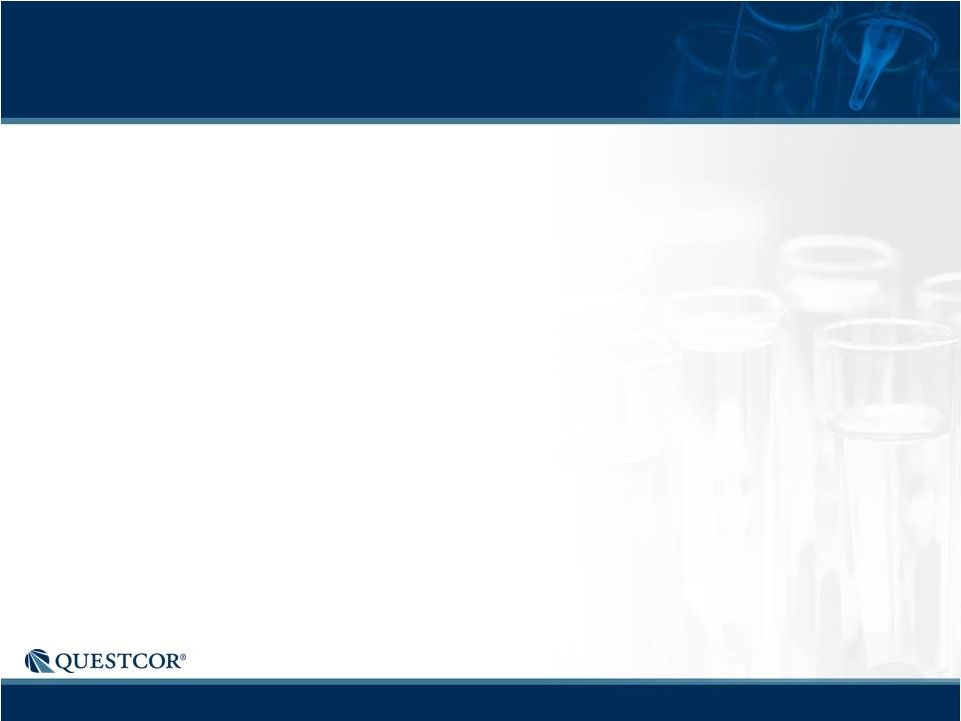Attached files
| file | filename |
|---|---|
| 8-K - FORM 8-K - QUESTCOR PHARMACEUTICALS INC | d537935d8k.htm |
 1
1
May 2013
NASDAQ:
QCOR
NASDAQ:
QCOR
Bank of America Merrill Lynch
Healthcare Conference
Don Bailey
Chief Executive Officer
Exhibit 99.1 |
 2
Safe Harbor Statement
Note: Except for the historical information contained herein, this press release contains
forward-looking statements that have been made pursuant to the Private Securities
Litigation Reform Act of 1995. These statements relate to future events or our future financial
performance. In some cases, you can identify forward-looking statements by terminology such
as "believes," "continue," "could," “ensuring,”
"estimates," "expects," "growth," "may," “momentum,” "plans," "potential," "remain," "should," “start,” "substantial,"
“sustainable” or "will" or the negative of such terms and other comparable
terminology. These statements are only predictions. Actual events or results may differ
materially. Factors that could cause or contribute to such differences include, but are not limited to,
the following: Our reliance on Acthar for substantially all of our net sales and profits;
Reductions in vials used per prescription resulting from changes in treatment regimens by
physicians or patient compliance with physician recommendations; Our ability to receive
high reimbursement levels from third party payers; The complex nature of our manufacturing process and the potential for
supply disruptions or other business disruptions ;The lack of patent protection for Acthar; and
the possible FDA approval and market introduction of competitive products; Our ability to
continue to generate revenue from sales of Acthar to treat on-label indications
associated with NS, MS, IS or rheumatology-related conditions, and our ability to develop
other therapeutic uses for Acthar; Research and development risks, including risks
associated with Questcor's work in the area of NS and Lupus, our reliance on third-parties to
conduct research and development and the ability of research and development to generate
successful results; The results of any pending or future litigation, investigations or
claims, including with respect to the investigation by the United States Attorney’s Office
for the Eastern District of Pennsylvania regarding the Company’s promotional practices and
litigation brought by certain shareholders arising from the federal securities laws,
currently pending in the United States District Court for the Central District of California; Our
ability to comply with federal and state regulations, including regulations relating to
pharmaceutical sales and marketing practices; Regulatory changes or other policy actions
by governmental authorities and other third parties in connection with U.S. health care
reform or efforts to reduce federal and state government deficits; An increase in the proportion
of our Acthar unit sales comprised of Medicaid-eligible patients and government
entities; Our ability to estimate reserves required for Acthar used by government entities
and Medicaid-eligible patients and the impact that unforeseen invoicing of historical
Medicaid prescriptions may have upon our results; Our ability to effectively manage our
growth, including the expansion of our sales forces, and our reliance on key personnel;
The impact to our business caused by economic conditions; Our ability to protect our proprietary
rights; The risk of product liability lawsuits; Unforeseen business interruptions and
security breaches; Volatility in Questcor's monthly and quarterly Acthar shipments,
estimated channel inventory, and end-user demand, as well as volatility in our stock price;
and Other risks discussed in Questcor's annual report on Form 10-K for the year ended
December 31, 2012 as filed with the Securities and Exchange Commission, or SEC, on
February 27, 2013, and other documents filed with the SEC.
The risk factors and other information contained in these documents should be considered in
evaluating Questcor's prospects and future financial performance. |
 3
A biopharmaceutical company focused on the
treatment of patients with serious, difficult-to-
treat autoimmune and inflammatory disorders
A biopharmaceutical company focused on the
treatment of patients with serious, difficult-to-
treat autoimmune and inflammatory disorders
Questcor |
 4
Flagship Product:
Flagship Product:
•
Profitable, positive cash flow, strong balance sheet
•
Profitable, positive cash flow, strong balance sheet
•
19 approved indications
•
19 approved indications
Key Therapeutic Areas:
Key Therapeutic Areas:
•
Nephrotic Syndrome, Multiple Sclerosis Relapse, Infantile
Spasms, Rheumatology Indications
•
Significant areas of unmet need; large growth potential
•
Nephrotic Syndrome, Multiple Sclerosis Relapse, Infantile
Spasms, Rheumatology Indications
•
Significant areas of unmet need; large growth potential
Strategy:
Strategy:
•
Expand awareness, appropriate use of Acthar in key specialties
•
Develop Rheumatology and other on-label indications
•
Expand awareness, appropriate use of Acthar in key specialties
•
Develop Rheumatology and other on-label indications
Financials:
Financials:
*In this presentation, the terms “Nephrotic Syndrome,”
“Multiple Sclerosis Relapse,”
“Rheumatology Indications,”
and
“Infantile
Spasms,”
and
their
abbreviations,
refer
to
on-label
indications
for
Acthar
associated
with
such
conditions.
Investors
should
refer
to
the
FDA
approved
Acthar
label,
which
can
be
found
at
http://www.acthar.com/files/Acthar-PI.pdf
Questcor Overview |
 Estimated
Allocation of Acthar Business Note: Questcor sells Acthar to a distributor
and does not have complete data with respect to end-use; allocation
based on internal estimates (Q1 2013). 5
Infantile
Spasms
~10%
Rheumatology
Indications
~10%
Other
MS Relapse
~30%
Nephrotic
Syndrome
~50% |
 6
Nephrotic Syndrome (NS)
•
Characterized by excessive spilling of protein
from the kidneys into the urine (proteinuria)
•
Caused by a number of underlying types of kidney
disease (eg, iMN, FSGS, IgA nephropathy, etc.)
•
Can result in end-stage renal disease (ESRD), dialysis,
transplant
•
Significant unmet need; few treatment options
•
Acthar is indicated to induce a diuresis or a remission
of proteinuria in the nephrotic syndrome without
uremia of the idiopathic type or that due to lupus
erythematosus
•
Characterized by excessive spilling of protein
from the kidneys into the urine (proteinuria)
•
Caused by a number of underlying types of kidney
disease (eg, iMN, FSGS, IgA nephropathy, etc.)
•
Can result in end-stage renal disease (ESRD), dialysis,
transplant
•
Significant unmet need; few treatment options
•
Acthar is indicated to induce a diuresis or a remission
of proteinuria in the nephrotic syndrome without
uremia of the idiopathic type or that due to lupus
erythematosus |
 7
•
A neurodegenerative disease occurring in about
400,000 patients in the US (>100,000 relapses/year)
•
Relapses range from mild to severe and can cause a
range of symptoms
–
Loss of sensation in the extremities
–
Loss of vision
–
Loss of ability to walk
•
Relapses have a measurable and sustained effect on
disability
in
MS
patients
1
•
A neurodegenerative disease occurring in about
400,000 patients in the US (>100,000 relapses/year)
•
Relapses range from mild to severe and can cause a
range of symptoms
–
Loss of sensation in the extremities
–
Loss of vision
–
Loss of ability to walk
•
Relapses have a measurable and sustained effect on
disability
in
MS
patients
1
Multiple Sclerosis (MS) Relapse
1
Lublin et al. Neurology
2003 |
 •
Devastating, ultra-rare form of childhood epilepsy
•
Can cause permanent developmental disabilities,
increased mortality
•
Acthar is often considered the “gold standard”
and is
currently used to treat 40-50% of IS patients
•
Devastating, ultra-rare form of childhood epilepsy
•
Can cause permanent developmental disabilities,
increased mortality
•
Acthar is often considered the “gold standard”
and is
currently used to treat 40-50% of IS patients
Infantile Spasms (IS)
8 |
 9
•
Rheumatology-related indications on the Acthar label*
–
Dermatomyositis/Polymyositis (DM/PM)
–
Systemic lupus erythematosus (Lupus)
–
Rheumatoid arthritis –
short term adjunctive
–
Psoriatic arthritis –
short term adjunctive
•
Each can pose a serious health risk if not adequately
controlled
•
Some cases difficult to manage; Acthar is an FDA-
approved treatment for select patients
•
Positive initial uptake; expanded Rheum Sales Force
from 12 to 55 reps
•
Rheumatology-related indications on the Acthar label*
–
Dermatomyositis/Polymyositis (DM/PM)
–
Systemic lupus erythematosus (Lupus)
–
Rheumatoid arthritis –
short term adjunctive
–
Psoriatic arthritis –
short term adjunctive
•
Each can pose a serious health risk if not adequately
controlled
•
Some cases difficult to manage; Acthar is an FDA-
approved treatment for select patients
•
Positive initial uptake; expanded Rheum Sales Force
from 12 to 55 reps
Rheumatology
*See http://www.acthar.com/files/Acthar-PI.pdf for specific
label information. 9 |
 10
•
Inflammatory neuromuscular diseases
that cause a loss of muscle strength and
mass
–
Significant quality of life issues; some patients
require walkers or wheelchairs
–
Can also cause significant lung impairment
–
Patients can experience acute exacerbations
(flares)
•
Commonly used DM/PM treatments
•
An estimated 30% of patients may need
an additional treatment alternative
*
Alternative
Needed
~20K
* Questcor sponsored market research study (2012)
~70,000 Patients (US)
Adequately
Treated
~50K
Dermatomyositis and Polymyositis (DM/PM)
Prednisone, plaquenil, methotrexate,
azathioprine, IVIG, Rituxan |
 11
Systemic Lupus Erythematosus (Lupus)
•
Chronic autoimmune disorder that can
effect virtually any area of the body
–
Patients can experience acute exacerbations
(flares)
•
Commonly used lupus treatments
•
An estimated 25% of patients may need
an additional treatment alternative
*
Alternative
Needed
~63K
~250K SLE Patients (US)
Adequately
Treated
~187K
Prednisone, plaquenil, methotrexate,
mycophenolate, azathioprine, Benlysta, Rituxan
* Questcor sponsored market research study (2012) |
 12
Rheumatoid Arthritis (RA)
•
Chronic autoimmune disorder that causes
inflammation of the synovial joints
–
Can be debilitating and lead to join destruction
–
Patients can experience acute exacerbations (flares)
•
Commonly used RA treatments
-
Prednisone, methotrexate, azathioprine, Remicade,
Humira, Rituxan
•
An estimated 5% of patients may need an
additional treatment alternative*
Alternative
Needed
~65K
* Questcor sponsored market research study, 2012
~1.3 million patients (US)
Adequately
Treated
~1.23M |
 13
Psoriatic Arthritis (PsA)
Alternative
Needed
~45K
* Questcor sponsored market research study, 2012
~900K patients (US)
•
Chronic autoimmune disorder manifesting as
both arthritis and psoriasis
–
Patients have both skin and joint manifestations
–
Patient can experience acute exacerbations (flares)
•
Commonly used PsA treatments
-
•
An estimated 5% of patients may need an
additional treatment alternative*
Prednisone, methotrexate, azathioprine, Remicade,
Humira
Adequately
Treated
~855K |
 14
Approved Acthar Rheumatology
Indications
1.3 Rheumatic Disorders:
As adjunctive therapy for short-term administration (to tide the
patient over an acute episode or exacerbation) in: Psoriatic
arthritis; Rheumatoid arthritis, including juvenile rheumatoid
arthritis (selected cases may require low-dose maintenance
therapy); Ankylosing spondylitis.
1.4 Collagen Diseases:
During an exacerbation or as maintenance therapy in selected
cases of: systemic lupus erythematosus, systemic
dermatomyositis (polymyositis). |
 15
How Does Acthar Work?
•
Treats variety of autoimmune/inflammatory conditions
•
Appears to modulate the immune system and associated
inflammatory response through binding to melanocortin
receptors
1,5-9
•
Activity extends beyond steroidogenesis
1,5-9
–
Binds to all 5 melanocortin receptors found on immune cells
–
Binds
to
cells
in
many
of
the
targeted
tissues
(e.g.,
kidney
podocytes)
–
Triggers the production of cortisol and other adrenal compounds through
binding to MC2R receptors found in the adrenal cortex
•
Acthar components have yet to be fully characterized
10
–
ACTH is believed to be the primary active component in Acthar, but there may be
others
•
Treats variety of autoimmune/inflammatory conditions
•
Appears to modulate the immune system and associated
inflammatory response through binding to melanocortin
receptors
1,5-9
•
Activity extends beyond steroidogenesis
1,5-9
–
Binds to all 5 melanocortin receptors found on immune cells
–
Binds
to
cells
in
many
of
the
targeted
tissues
(e.g.,
kidney
podocytes)
–
Triggers the production of cortisol and other adrenal compounds through
binding to MC2R receptors found in the adrenal cortex
•
Acthar components have yet to be fully characterized
10
–
ACTH is believed to be the primary active component in Acthar, but there may be
others
1
Arnason et al. Mult Sclerosis J. 2012;
2
Arya et al. J Child Neuro 2012;
3
Bomback et al. Amer J. Neph
2012;
4
Levine, Drug Design, Dev & Therapy, 2012.
5
Catania, et al. Pharmacol Rev. 2004;
6
Stafstrom,
et al. J Child Neuro 2011;
7
Manna SK, J Immunol. 1998;
8
Gong R. Nat Rev Nephrol. 2011;
9
Bohm et
al. Endocrine Reviews 2012;
10
H.P. Acthar Gel package insert. Questcor Pharmaceuticals, Inc., 2011. 1,3,5,6,8,9
1-4 |
 16
•
Significantly increasing investment in R&D
–
Have funded or have approved funding for ~70 projects
–
Company sponsored pre-clinical and clinical studies
–
Independent physician sponsored studies
•
Gaining an understanding of the biological properties of Acthar
–
Specific biochemical pathways, cells, and tissues
–
Immunomodulation and anti-inflammatory effects
•
Expanding the body of evidence for on-label indications
•
Exploring possible new indications and targets
–
Autoimmune/inflammatory conditions
•
Significantly increasing investment in R&D
–
Have funded or have approved funding for ~70 projects
–
Company sponsored pre-clinical and clinical studies
–
Independent physician sponsored studies
•
Gaining an understanding of the biological properties of Acthar
–
Specific biochemical pathways, cells, and tissues
–
Immunomodulation and anti-inflammatory effects
•
Expanding the body of evidence for on-label indications
•
Exploring possible new indications and targets
–
Autoimmune/inflammatory conditions
Advancing Our Understanding of the
Science Behind Acthar |
 17
•
Idiopathic Membranous Nephropathy
–
Phase 4 trial ongoing
–
Refractory, non-responsive, or have relapsed on standard therapies
•
Persistently Active Lupus
–
Phase 4 trial initiated 4Q 2012
–
Daily Acthar administration over a 6-month period
•
Lupus Exacerbations (flares)
–
Prospective investigator initiated
–
Enrollment completed
–
Top line data to be published Summer 2013
•
DM/PM Studies
–
ADAPT Patient Registry currently collecting data
•
Idiopathic Membranous Nephropathy
–
Phase 4 trial ongoing
–
Refractory, non-responsive, or have relapsed on standard therapies
•
Persistently Active Lupus
–
Phase 4 trial initiated 4Q 2012
–
Daily Acthar administration over a 6-month period
•
Lupus Exacerbations (flares)
–
Prospective investigator initiated
–
Enrollment completed
–
Top line data to be published Summer 2013
•
DM/PM Studies
–
ADAPT Patient Registry currently collecting data
Ongoing Research in Approved Indications |
 18
•
Diabetic Nephropathy
–
One of the most common causes of end-stage renal disease in the U.S.
–
Phase 2 IND trial; Approx 40% enrolled
•
Amyotrophic Lateral Sclerosis (ALS)
–
Fatal neurological disease caused by progressive loss of motor neurons
in the brain and spinal cord
•
Inflammatory component to ALS contributes to disease pathology/progression
•
Mean survival time from diagnosis is 3-5 years
•
Affects ~30K people in US and ~30K in Europe; Peak incidence 40-70 years of
age –
Phase 2 IND study to be initiated in Q2 2013; site enrollment underway
–
Request for Orphan Drug Designation submitted to FDA
–
Study results could help determine whether to pursue ALS as a
potential new Acthar indication
•
Diabetic Nephropathy
–
One of the most common causes of end-stage renal disease in the U.S.
–
Phase 2 IND trial; Approx 40% enrolled
•
Amyotrophic Lateral Sclerosis (ALS)
–
Fatal neurological disease caused by progressive loss of motor neurons
in the brain and spinal cord
•
Inflammatory component to ALS contributes to disease pathology/progression
•
Mean survival time from diagnosis is 3-5 years
•
Affects ~30K people in US and ~30K in Europe; Peak incidence 40-70 years of
age –
Phase 2 IND study to be initiated in Q2 2013; site enrollment underway
–
Request for Orphan Drug Designation submitted to FDA
–
Study results could help determine whether to pursue ALS as a
potential new Acthar indication
Acthar Label Enhancement Strategy |
 19
•
Complex formulation and pharmacology, with
–
Slow release gel formulation
–
Complex and not well characterized (research is ongoing)
•
Formulation and manufacturing trade secrets inherent
with Acthar
•
Future synthetics possible, but in specific indication
–
Clinical trial(s) and other development work likely required
–
Multi-year pathway; challenging IP landscape
•
Complex formulation and pharmacology, with
–
Slow release gel formulation
–
Complex and not well characterized (research is ongoing)
•
Formulation and manufacturing trade secrets inherent
with Acthar
•
Future synthetics possible, but in specific indication
–
Clinical trial(s) and other development work likely required
–
Multi-year pathway; challenging IP landscape
Biosimilar Pathways Highly Challenging
multiple receptor binding properties |
 20
Q1 –
2013
Q1 –
2012
Net Sales ($M)
$135.1
$96.0
Fully Diluted, GAAP EPS
$0.65
$0.58
Fully Diluted, Non-GAAP EPS
$0.76
$0.61
Cash flow from operations ($M)
$41.5
$40.9
Diluted shares outstanding
60.3
66.5
Q1-2013 Financial Results |
 21
•
Identifying and expanding Acthar therapeutic role in existing
and new indications
•
Long term investment in R&D --
doubled R&D spending in 2012
•
Highly selective, strategic diversification
•
Have returned $379 million to shareholders through share
repurchases and dividends*
–
22.2 million shares repurchased
•
6.3 million shares remain available for repurchase under share
repurchase program*
•
Quarterly dividend increased to $0.25 per share during Q2-
2013
*Data as of 3/31/13
•
Identifying and expanding Acthar therapeutic role in existing
and new indications
•
Long term investment in R&D --
doubled R&D spending in 2012
•
Highly selective, strategic diversification
•
Have returned $379 million to shareholders through share
repurchases and dividends*
–
22.2 million shares repurchased
•
6.3 million shares remain available for repurchase under share
repurchase program*
•
Quarterly dividend increased to $0.25 per share during Q2-
2013
*Data as of 3/31/13
Committed to Creating Long Term Value
for Shareholders |
 22
Acthar has a unique therapeutic role and
Acthar has a unique therapeutic role and
sustainable competitive advantages
sustainable competitive advantages
Acthar is approved for 19 indications, many
Acthar is approved for 19 indications, many
in markets with sizable unmet need
in markets with sizable unmet need
NS and MS market penetration remains
NS and MS market penetration remains
modest; Rheumatology sales increasing
modest; Rheumatology sales increasing
rapidly
rapidly
Questcor is increasing investment in R&D
Questcor is increasing investment in R&D
Profitable, strong cash flow and balance
Profitable, strong cash flow and balance
sheet
sheet
Investment Highlights
22 |
 May
2013 May 2013
NASDAQ:
QCOR
NASDAQ:
QCOR |
 24
Reconciliation of Non-GAAP Adjusted
Financial Disclosure
Three Months Ended
03/31/13
Three Months Ended
03/31/12
Adjusted
net
income
per
share
-
basic
$
0.79
$
0.64 Share-based
compensation expense (1) (0.07)
(0.02)
Depreciation and amortization expense (2)
(0.03)
(0.00)
Interest expense associated with contingent
consideration (3)
(0.00)
--
Compensation expense associated with BV Trust
Agreement (4)
(0.00)
--
Foreign currency transaction loss (5)
(0.01)
--
Tax adjustments (6)
--
(0.01)
Impairment of purchased technology (7)
(0.01)
--
Net
income
per
share
-
basic
$
0.68
$
0.61 Adjusted
net
income
per
share
-
diluted
$
0.76
$
0.61 Share-based
compensation expense (1) (0.07)
(0.02)
Depreciation and amortization expense (2)
(0.02)
(0.00)
Interest expense associated with contingent
consideration (3)
(0.00)
--
Compensation expense associated with BV Trust
Agreement (4)
(0.00)
--
Foreign currency transaction loss (5)
(0.01)
--
Tax adjustments (6)
--
(0.00)
Impairment of purchased technology (7)
(0.01)
--
Net
income
per
share
-
diluted
$
0.65
$
0.58 Net
income
per
share
–
basic
and
diluted
may
not
foot
due
to
rounding.
Use of Non-GAAP Financial Measures
items from GAAP net income:
1. Share-based compensation expense.
2. Depreciation and amortization expense
3. Interest expense associated with the net present value
adjustment of the contingent consideration.
4. Compensation expense associated with the BV Trust
agreement.
5. Foreign currency transaction loss.
6. Tax adjustments primarily relate to write-off of 1997-
2000 Federal R&D tax credits.
4. Impairment of purchased technology related to our
acquisition of Doral.
Our
“non-GAAP
adjusted
net
income”
excludes
the
following |
 25
Receptor
Prevalent Tissue/Cells with Receptor
MC1R
Podocytes, Renal Mesangial Cells,
Endothelial Cells, Tubular Epithelial Cells,
Macrophages, Melanocytes, Immune/Inflammatory
Cells, Kerantinocytes, CNS
MC2R
Adrenal Cortex (Steroidogenesis), Adipocytes
MC3R
CNS, Macrophages
MC4R
Podocytes, Renal Mesangial Cells (?)
Endothelial Cells, Tubular Epithelial Cells, CNS
MC5R
CNS, Exocrine Glands, Lymphocytes, Podocytes
Adapted from Gong 2011, Catania 2004, Schioth 1997
Acthar Binds to Melanocortin Receptors |
